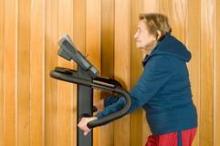A structured physical activity program reduced the rate of major mobility disability among sedentary men and women aged 70-89 years who were at high risk for the condition, in a randomized clinical trial presented at the annual meeting of the American College of Sports Medicine in Orlando and simultaneously published online May 27 in JAMA.
Compared with a sedentary health education intervention, the physical activity program was particularly effective in the large subgroup of participants who had the lowest physical function at baseline, said Dr. Marco Pahor of the department of aging and geriatric research, University of Florida, Gainesville, and his associates in the Lifestyle Interventions and Independence for the Elderly (LIFE) trial.
"These results suggest the potential for structured physical activity as a feasible and effective intervention to reduce the burden of disability among vulnerable older persons, in spite of functional decline in later life," they noted (JAMA 2014 May 27 [doi:10.1001/jama.2014.5616]).
In what they described as the largest and longest lasting randomized trial of physical activity in older persons, Dr. Pahor and his associates assessed 1,635 participants of diverse ethnic/racial backgrounds residing in rural, urban, and suburban communities. These study subjects (mean age, 78.9 years) were followed at geriatric health facilities at eight medical centers across the country.
They were deemed to be at high risk for mobility disability – losing the ability to walk 400 meters within 15 minutes without sitting, leaning, or the assistance of a walker or another person – based on functional limitations determined by the Short Physical Performance Battery (SPPB). This is considered an excellent proxy for impaired mobility in the community, the investigators said, and maintaining such mobility is central to retaining independence and a good quality of life.
The study participants were randomly assigned to receive either a structured physical activity intervention (818 people) or a health education intervention (817 people) and followed at 6-month intervals for at least 2 years.
The activity intervention involved two visits per week to the medical center, plus home-based activity three-four times per week. The goal was to walk for at least 30 minutes daily at moderate intensity and to perform 10 minutes of lower-extremity strength training with ankle weights, 10 minutes of balance training, and large muscle–group flexibility exercises daily.
The education program involved weekly workshops for 26 weeks, followed by monthly workshops thereafter, in which a health educator spoke about topics related to "successful aging," such as negotiating the health care system, travelling safely, obtaining preventive services and screenings, finding reliable health information, and nutrition. This intervention included 5-10 minutes of seated, gentle, upper-extremity stretching or flexibility exercises at each meeting.
The primary outcome was developing mobility disability – losing the ability to walk 400 meters within 15 minutes at their usual pace, without overexerting and without assistance, at the 2-year follow-up visit. This occurred in 30.1% of the activity group, which was significantly lower than the 35.5% rate in the education group, Dr. Pahor and his associates said.
A subgroup comprising 44.7% of the entire study population had the lowest physical function at baseline, reflected in scores of less than eight on the SPPB. They derived "considerable benefit" from the activity intervention and showed the largest reduction in the rate of impaired mobility, with a hazard ratio of 0.81.
People in the activity group had the same number of hospitalizations as those in the education group, as well as the same mortality. However, the mortality data in this study are considered inconclusive, the researchers said, because there were very few deaths overall.
The LIFE study was supported by the National Institutes of Health, the National Institute on Aging, the National Heart, Lung, and Blood Institute, the Claude D. Pepper Older Americans Independence Centers, the National Center for Research Resources, the Boston Rehabilitation Outcomes Center, the Department of Veterans Affairs, and the Department of Agriculture. Dr. Pahor reported no financial conflicts of interest; his associates reported ties to numerous industry sources.


